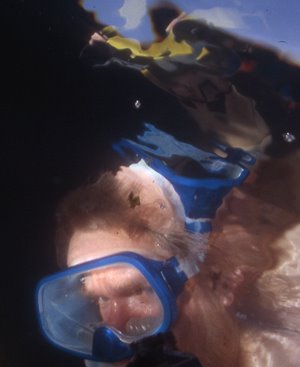Planets Found and Lost
News from the World O' Science:
We may have seen our first extra-galactic planet. Micro-lensing may have shown that a star in the Andromeda Galaxy has a planet six times the size of Jupiter.
The advantage of microlensing is that it works best for more distant objects, so it's ideal for planet hunting in other galaxies. In theory, it should be possible to see Earth-size objects in this way. The disadvantage is that microlensing is a relatively rapid, one-off event that lasts a few days at most. That makes observations difficult to verify.
It's hard to see individual stars like this, let alone planets. Astronomers have so far spotted only about a dozen stars in Andromeda in this way, and plans are afoot to search for lots more.
But get this: the light from one of these Andromedan stars showed a distinct variability that the discoverers attribute to an orbiting companion . . .
And (as Ralf pointed out elsewhere) a couple French astronomers have created a computer model of the next 5 billion years of our solar system's history. Result: Cosmic Catastrophe!
A number of computations resulted in Mercury's orbit collapsing and Mercury colliding with the Sun after about 4 Gyr. In a run where the minor axis was shrunk by 812 mm (32in), Mercury slammed into Venus just after 1.7 Gyr. In what the authors describe as their most interesting simulation—one where Mercury's axis was decreased by 468 mm (18.4 in)—Mars and Earth had a close encounter, passing within 794 km of one another.
Using this as an interesting starting point, the authors ran another series of 201 integrations where the semi-major axis of Mars was changed by up to 30 mm. Within 100 Myr of starting these integrations, five of the simulations resulted in Mars being ejected from the solar system. All of the remaining 196 cases resulted in various collisions between Earth, Mars, Venus, Mercury, and/or the Sun.
We'd better get off this planet in the next billion years or so, or else we're toast!
We may have seen our first extra-galactic planet. Micro-lensing may have shown that a star in the Andromeda Galaxy has a planet six times the size of Jupiter.
The advantage of microlensing is that it works best for more distant objects, so it's ideal for planet hunting in other galaxies. In theory, it should be possible to see Earth-size objects in this way. The disadvantage is that microlensing is a relatively rapid, one-off event that lasts a few days at most. That makes observations difficult to verify.
It's hard to see individual stars like this, let alone planets. Astronomers have so far spotted only about a dozen stars in Andromeda in this way, and plans are afoot to search for lots more.
But get this: the light from one of these Andromedan stars showed a distinct variability that the discoverers attribute to an orbiting companion . . .
And (as Ralf pointed out elsewhere) a couple French astronomers have created a computer model of the next 5 billion years of our solar system's history. Result: Cosmic Catastrophe!
A number of computations resulted in Mercury's orbit collapsing and Mercury colliding with the Sun after about 4 Gyr. In a run where the minor axis was shrunk by 812 mm (32in), Mercury slammed into Venus just after 1.7 Gyr. In what the authors describe as their most interesting simulation—one where Mercury's axis was decreased by 468 mm (18.4 in)—Mars and Earth had a close encounter, passing within 794 km of one another.
Using this as an interesting starting point, the authors ran another series of 201 integrations where the semi-major axis of Mars was changed by up to 30 mm. Within 100 Myr of starting these integrations, five of the simulations resulted in Mars being ejected from the solar system. All of the remaining 196 cases resulted in various collisions between Earth, Mars, Venus, Mercury, and/or the Sun.
We'd better get off this planet in the next billion years or so, or else we're toast!
Labels: astronomy, cosmic collision, extra-solar planets


3 Comments:
I believe that the Milky Way and the Andromeda Galaxy are due to collide within the next 2-3 billion years. That will be a more catastrophic event long before some of these outcomes
Phil
Given that nothing really bad seems to have happened to any of the planets in the last 3-4 billion years or so, I'd suspect the solar system is more stable than the calculations make it (or maybe we've just been really, really lucky so far).
Airbags. Really, really big airbags.
(Why, yes, I have been reading Karl Schroeder's Virga books recently. Why do you ask?)
Post a Comment
<< Home